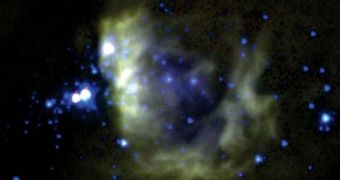When it comes to answering questions related to how stars are formed, astronomers don't yet have the full answer. Naturally, they do know how things go generally, but the details of these remarkably-intricate processes still elude them. Now, thanks to a new set of observations conducted using an advanced Australian telescope, researchers have been able to image a massive cloud of cosmic dust and hydrogen gas in the process of falling in on itself, which is how astronomers believe new stars appear.
Studying the phenomenon more closely could finally allow the scientific community to gain more insight into stellar formation. The Holy Grail in this line of research is discovering how massive stars form. These enormous fireballs have masses several tens of times larger than that of the Sun, even if they are short-lived. Unlike yellow dwarfs or other smaller stars, the massive variety only endures for a few million years. For comparison, the Sun has a lifespan of about 10 billion years. Beyond that limit, it will turn into a white dwarf, which will continue to burn its helium fuel for a long time afterwards.
“Astronomers are still debating the physical processes that can generate these big stars,” explains University of Florida astronomer Dr Peter Barnes, the leader of the group that conducted the new investigation. “Massive stars are rare, making up only a few per cent of all stars, and they will only form in significant numbers when really massive clouds of gas collapse, creating hundreds of stars of different masses. Smaller gas clouds are not likely to make big stars,” the expert adds. He goes on to say that – due to the fact that most clouds capable of forming massive stars are more than 1000 light-years away from Earth – observing the stellar formation mechanisms has remained an elusive goal.
But, by using the 22-meter 'Mopra' radio telescope near Coonabarabran, New South Wales, the UF group managed to get a clearer view of a stellar nursery just as it collapsed. The finding was fortuitous, as the group was looking at about 200 gas clouds, says Anglo-Australian Observatory expert Dr Stuart Ryder. “With clouds like this we can test theories of massive star cluster formation in great detail,” he reveals, adding that the newly-found structure, dubbed BYF73, is located in the constellation Carina, some 8,000 light-years away from our planet.
Using the Chile-based Atacama Submillimeter Telescope Experiment (ATSE) observatory, another team of astronomers was able to confirm the discovery, ScienceDaily reports. Details of the stellar nursery, and of the active processes going on inside, can be found in the latest issue of the esteemed scientific journal Monthly Notices of the Royal Astronomical Society.

 14 DAY TRIAL //
14 DAY TRIAL //